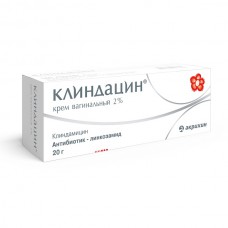Expiration date: 09/2025
The composition and form of issue:
Vaginal cream 100 g contains:
clindamycin phosphate 2 g
auxiliary substances: sodium benzoate castor oil 1, 2-propylene glycol emulsifier polyethylene oxide
in aluminum tubes of 20 and 40 g in a pack of cardboard 1 tube complete with 3 or 7 applicators respectively.
Description of dosage form:
Cream from white to white with a yellowish or creamy shade of color. Slight peculiar smell is allowed.
Characteristic:
Antibiotic group lincosamides in lekpharma for vaginal use.
Pharmacokinetics:
After a single vaginal administration of 100 mg of clindamycin, systemic absorption averages 4% of the administered dose. Smahv plasma is 20 ng/ml.
Description of the pharmacological action:
The mechanism of action is associated with a violation of intracellular protein synthesis in the microbial cell at 50S subunit ribosome.
It has a wide spectrum of action, has bacteriostatic effect, in higher concentrations against some microorganisms — bactericidal.
Active against microorganisms that cause bacterial vaginosis: Gardnerella vaginalis, Mobiluncus spp., Bacteroides spp., Mycoplasma hominis, Peptostreptococcus spp. Clindamycin is not sensitive to Trichomonas vaginalis and Candida albicans.
Indications:
Bacterial vaginosis caused by drug-sensitive microorganisms.
Contraindications:
Hypersensitivity to clindamycin or lincomycin.
Application during pregnancy and breast-feeding:
Clinical studies on the use of clindamycin in women in the first trimester of pregnancy was not carried out, so the use of the drug is only possible when the expected benefit to the mother exceeds the risk to the fetus.
The use of in II and III trimestrah pregnancy is possible, because not discovered any adverse effects on the fetus.
It is not known whether clindamycin is excreted in the mother's milk during intravaginal use, so the benefits of the drug during breastfeeding and the possible risk to the baby should be compared.
Side effect:
Possible development of allergic reactions, irritation at the injection site, cervicitis, vaginitis, vulvovaginal candidiasis.
Drug interaction:
Antagonistic interaction between clindamycin and erythromycin was noted. There is a cross-resistance between clindamycin and lincomycin.
Method of application and doses:
Intravaginal, with an applicator. The recommended single dose is 100 mg of clindamycin (one complete applicator), preferably before bedtime. The course is 3-7 days.
Instructions for use
Disposable applicators attached to the package with Clindacin are designed for proper administration of cream into the vagina.
1. Remove the cap of the tube with cream. Screw the plastic applicator onto the threaded neck of the tube.
2. Squeezing the tube from the opposite end, gently squeeze the cream into the applicator. The applicator piston moves independently as the required volume is filled. The applicator is filled when the piston reaches the stops.
3. Lying on your back, take the applicator and insert it into the vagina as far as possible, but so as not to cause discomfort.
4. Slowly push the piston all the way.
5. Carefully remove the applicator from the vagina and discard it.
Overdose:
With intravaginal application of the drug overdose is not installed.
Special instruction:
With prolonged use of the drug can cause excessive growth sensitive to it microorganisms, in particular fungi of the genus Candida.
Given the possibility of a minimum systemic absorption of the drug (approximately 4%), it is impossible to exclude the occurrence of diarrhea in the background of the drug. In this case, the drug should be canceled.
It is not recommended to use simultaneously with other intravaginal agents. Efficacy and safety of clindamycin in intravaginal use in children is not established.


